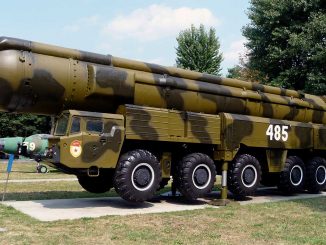There indeed is a limit to what one can make up. Pictures of actual intact Russian T-80 tanks being happily towed away by farmers on their green John Deeres, or of a young lady selfying herself firing up a stray BTR and driving it away while laughing her head off could easily be mistaken for rejected scenes from a Stanley Kubrick film.
By Eric H. Biass – March 9, 2022 –
With the massive footage showing us the same scenes of abandoned heavy armoured vehicles in very different geographical locations of the immense Ukrainian plains, little doubt is really allowed as to their authenticity. There indeed is a limit to what one can make up.
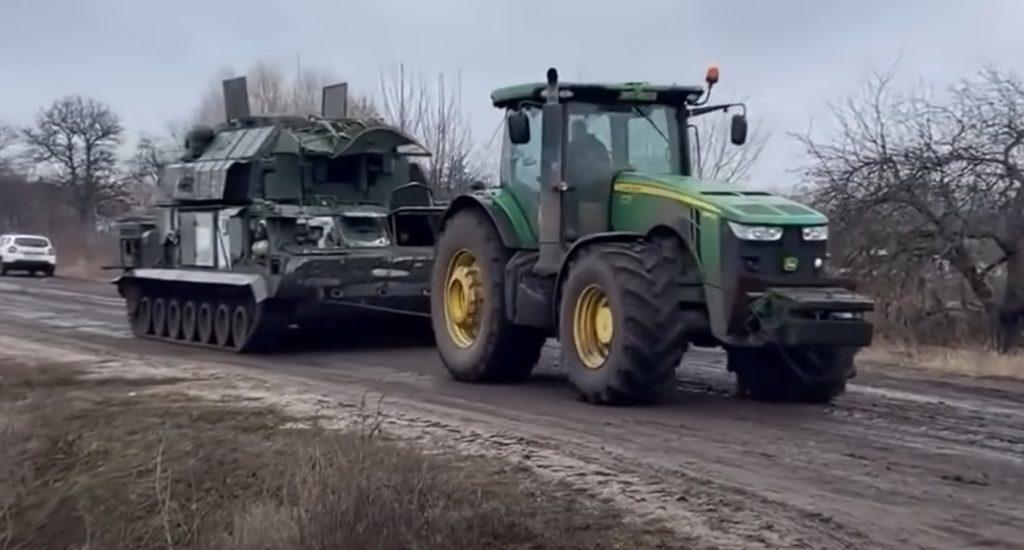
Pictures of actual intact Russian Tor-M2U short-range air defense missile system based on a GM-352 tracked chassis being happily towed away by farmers on their green John Deeres, or of a young lady selfying herself firing up a stray BTR and driving it away while laughing her head off could easily be mistaken for rejected scenes from a Stanley Kubrick film.

But they belong to a bewildering reality. They are a historical testimony of an excruciatingly painful lack of logical thinking – or is it plain sloppiness? Painful in any case as it also results in totally unnecessary heartbreaking sufferings amongst a completely innocent population.
Source : Ukraine – Russia: Analysis of the military situation after 10 days of war by Xaviel Tytelman (École de guerre économique, Paris) – March 8, 2022.[1]
But they belong to a bewildering reality. They are a historical testimony of an excruciatingly painful lack of logical thinking – or is it plain sloppiness? Painful in any case as it also results in totally unnecessary heartbreaking sufferings amongst a completely innocent population.
Pantsir Air-Defence System
When not bogged down to its belly in Ukrainian mud fields, this vehicle, known as the Pantsir, is in fact what can be described as a truly nasty piece of work from an operational standpoint. Resting on a massive 38-tonne, 8×8 Kamaz chassis, the Pantsir developed by KBP in Tula in the mid-1990s is a self-contained medium-range (approx. 25km) air defence system that carries its own search and tracking radars, a full complement of nine ready-to-fire missiles and two 30mm close-in guns.
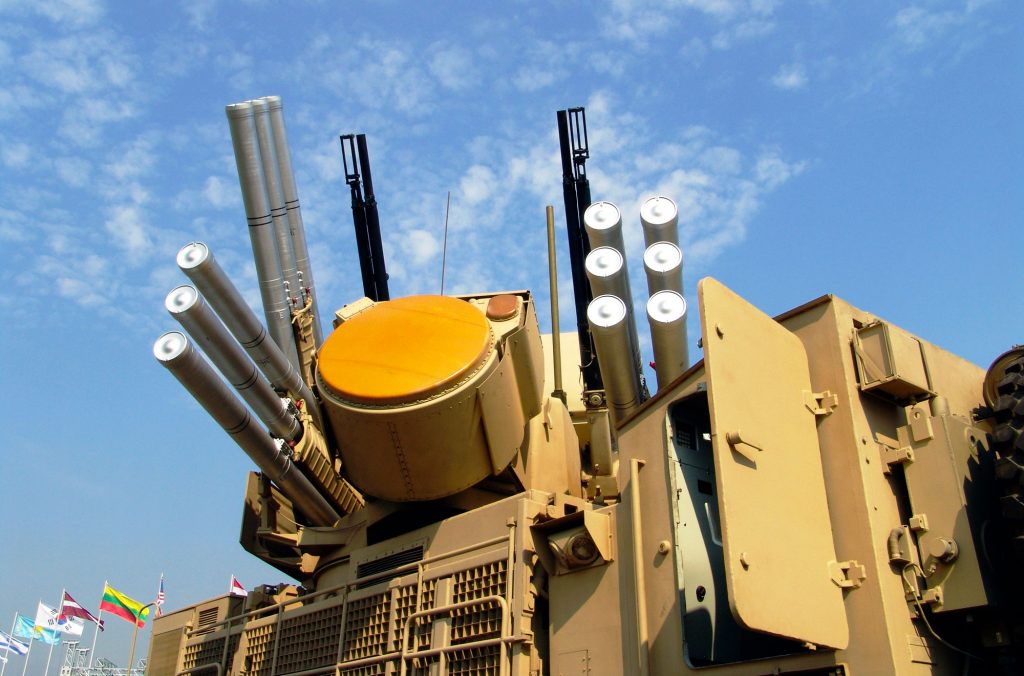
Radars, missiles and guns are all mounted on a turret which the radars automatically steer in the direction of the threat. The combination of gun and missile enables the Pantsir to provide a seamless range coverage with the guns coping with very short range and low altitude threats, after which the missiles cut in to deal with threats up to 49,000ft altitude.
In a manner that is no longer applied in similar weapon systems in the West, the actual missile has no active seeker or homing head per se, but is continuously stirred to its target by radio co-ordinates transmitted by the tracking system, which allegedly has the ability to guide two missiles (four on later models) to distinct targets.
A tracked vehicle-mounted version exists, although its agility is currently questioned when looking at the number of T-80 tanks and humongous 152.3mm calibre Msta self-propelled howitzers currently stuck deep in the Ukrainian Rasputitsa gunge.[2]
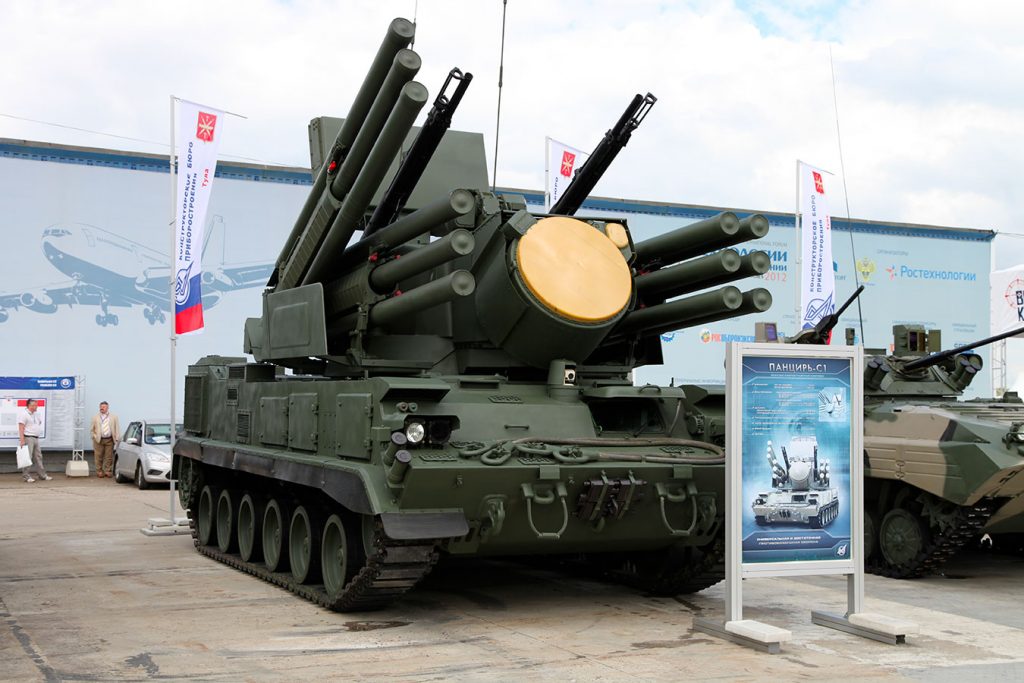
The Pantsir’s self-containabilty is also its Achilles’ heel, because while it enables it to be highly autonomous, it makes its two essential components – the launchers and the trackers (radars) – simultaneously vulnerable as the weak point of any artillery system is the radar, which immediately attracts any anti-radiation weapon in the vicinity as soon as it is switched. Western systems now tend to separate radars and launchers so that in the event of a strike, the surviving launcher unit can immediately be controlled by another radar set. This also offer a welcome safety factor to the crew whose command posts are located out of harm’s way. Anyhow, once dug out a tanked up, there is little doubt that some crafty Ukrainians will give this Pantsir a new, and very useful lease on life for the more hard days to come, but with its radars aimed the other way round this time. Another two Pantsirs have also been captured, but believed not lucky enough to see another day
Western equivalents of the Pantsir are the American IM-Shorad and the European Aster missile-based Samp/T.
Is there a word for logistics in Russian?
History seems to repeat itself. In a bewildering way for the author at least, with the resurgence of memories of a missile and weapons depot in former Eastern Germany very shortly after the infamous wall was torn down. His mission at the time was to report on the activity of a firm specialised in the recycling of ordnance, including missiles. The sight of piles of soviet-calibre ammunition canteens made of thick wooden boards knocked together with long and fat carpentry nails inevitably raised a fundamental question: how on earth is a soldier expected to rip these open on the front line without a sturdy crow’s foot on hand? But that is not all. Assuming the crate is finally opened, the ammo still needs to be freed out of their large sardine-like tins. Even supposing a tin opener is furnished, just try imagine opening these up in anger, wearing gloves on deep frozen battlefield. The packaging designer probably did a brilliant job of making sure that the ammo would arrive where it should absolutely intact even if it fell off the back of a lorry on a bumpy trail. In a typically Soviet manner, what happened next was none of his business.
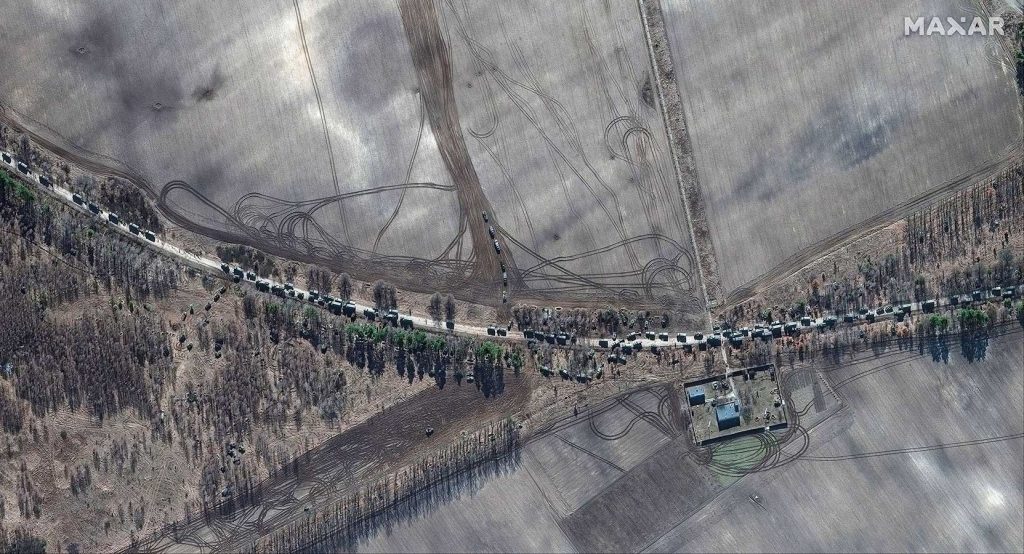
It must be in the Russian military DNA. We all know that the invasion of Ukraine is far from unravelling as planned. Take the above story, repeat its pattern in all the domains of a military structure and you get a pretty good clue as to the causes of the shambles evidenced by the satellite views seen here.
The causes are multiple but inexorably boil down to the sheer incapability of the Soviet-inherited chain of command to precisely ensure that the links of that chain are actually linked together: wrong time of the year, wrong planning, wrong materiel maintenance planning, cheaply sourced supplies (notably of tyres, said to originate from China!), virtually non-existing routine maintenance procedures – all result from a sloppy high-end command thinking pattern.[1] And it goes on and on. Yesterday for example, the Russian Air Force wanted to operate from one of the more centralised air bases, but suddenly remembered that they had shelled its runways a few days earlier. They might get there in the end, but they obviously haven’t thought of how they are going to be able to stay there. It all has to so with the earth-shattering dynamics of a play by Chekhov.
Eric H. Biass
[1] See : Ukraine – Russia: Analysis of the military situation after 10 days of war by Xaviel Tytelman (École de guerre économique, Paris) – March 8, 2022.
[2] See Raspoutitsa, When You Hold Us! – European Security by Joël-François Dumont (March 7, 2022).








